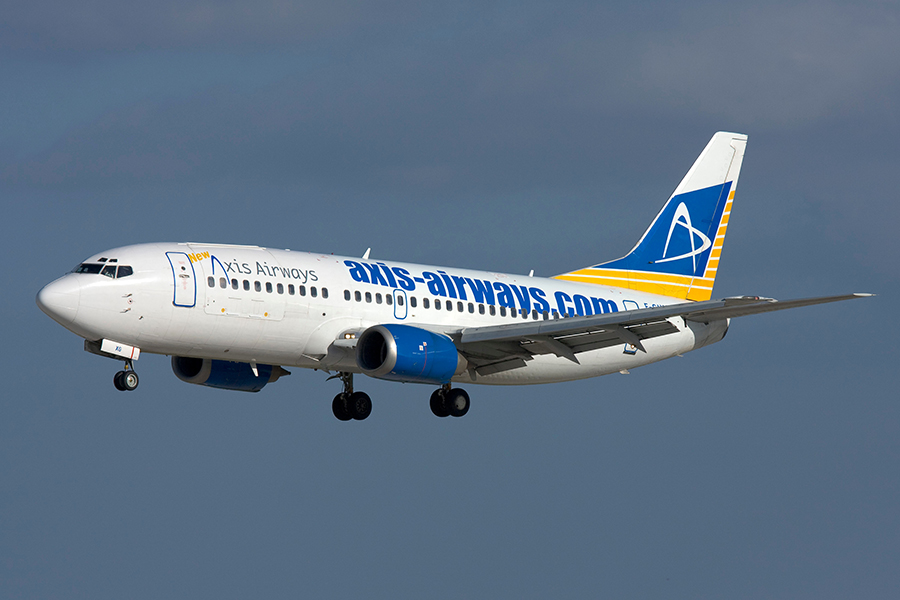-
Key Takeaways
-
What Is the PAVE Checklist?
- When Should You Use It?
- What If You Spot an Issue?
-
Pilot: Assessing Personal Readiness
- Breaking Down IMSAFE
-
Aircraft: Determining Airworthiness
- Documentation Checks
- When Things Go Wrong: A Real-World Example
-
Environment: Analyzing Weather and Terrain
- Weather
- Terrain and NOTAMs
- Why Pre-Flight Environmental Planning Matters
-
External Pressures: Managing Stress and Decision-Making
- How Do External Pressures Affect Decision-Making?
-
Conclusion
A checklist is about more than ticking boxes; it’s about thinking ahead, anticipating challenges, and making choices that keep you and your passengers safe.
The PAVE checklist is a framework to help you ask the right questions and address the details that matter.
Let’s unpack what makes PAVE an indispensable tool for every pilot who values safety and precision.
Key Takeaways
- You can assess if you’re fit to fly using the IMSAFE checklist.
- Make sure your aircraft is airworthy and check its documentation before flying.
- While you cannot control your flight environment, you can always prepare for it.
- Always prioritize safety, and don’t let external pressures affect your decisions.
What Is the PAVE Checklist?
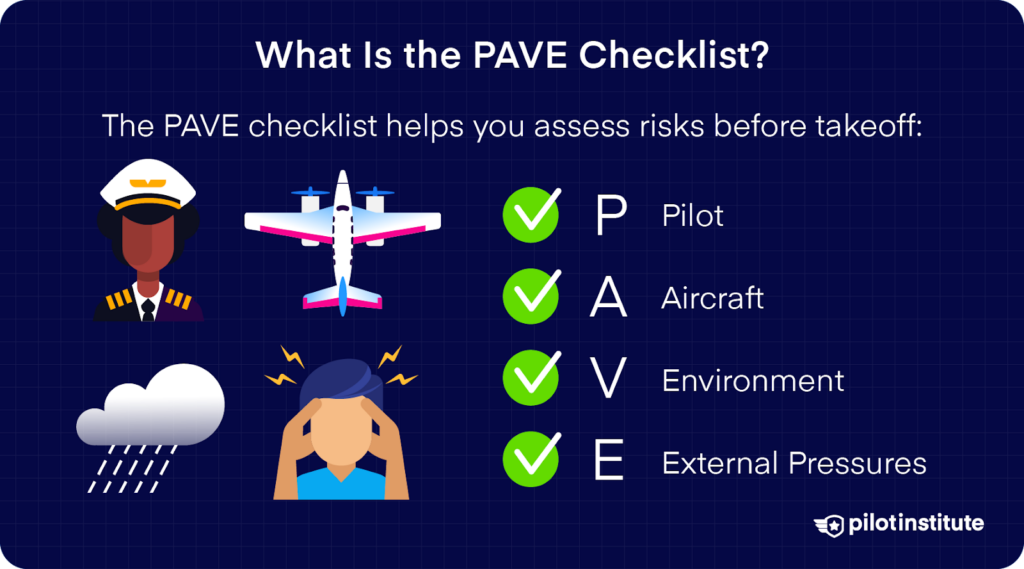
A safe flight starts with good preparation. You’ll have to think about the risks for all factors at play before you get in the cockpit. With this, the PAVE checklist will be your best friend. It stands for:
- P: Pilot
- A: Aircraft
- V: Environment
- E: External Pressures
What’s the use of this checklist? It encourages you to slow down and consider every aspect of your flight. This keeps you from missing any important details. You’ll also be less likely to make rash decisions under pressure.
With this handy checklist, flight planning becomes a structured, manageable process.
When Should You Use It?
The PAVE checklist is most effective during pre-flight preparation. It gives you a clear outline to spot potential risks before they escalate into disaster.
You can also use it before starting your pre-flight checks, since PAVE gives you a big-picture overview. It ensures all components of your flight align with safety standards.
PAVE is a great tool when planning your route. It helps you evaluate the weather, terrain, and airspace ahead. And if you ever feel unsure about a decision, you can always go back to PAVE to help you choose the safest option.
But it’s not just useful during pre-flight preparation. PAVE helps you make decisions throughout the entire flight. Keep going back to the checklist in the air; it will help you spot any issues and adjustments you need to make.
What If You Spot an Issue?
Not every flight goes as planned, but catching a problem early makes it much easier to handle. If the issue is with the pilot, like if you’re feeling unwell or distracted, it’s always safer to postpone the flight or let someone else take over.
What if you spot maintenance problems or low fuel? You should take the time to fix these before flying. Never skip or rush through this step.
When it comes to the environment, such as bad weather or tough terrain, you can adjust your route, delay your trip, or cancel altogether.
External pressures, like tight schedules or passenger expectations, can also push you into risky decisions. The right call is always to communicate openly and reschedule when safety is at stake.
Pilot: Assessing Personal Readiness
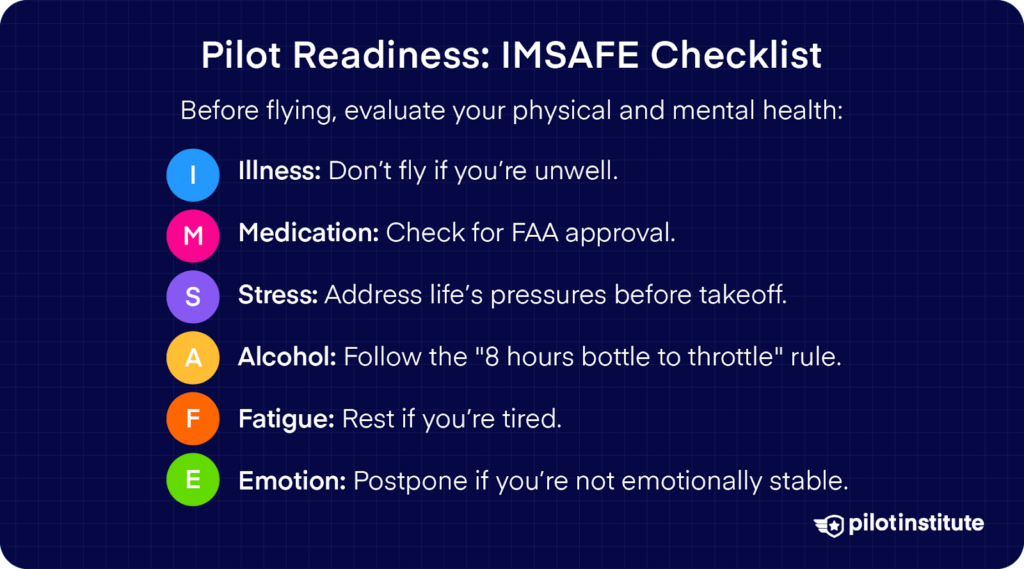
Now, let’s go through each component in PAVE. And the first item on this checklist is you, the pilot.
When it comes to flying, your readiness as a pilot matters just as much as the condition of the aircraft. Evaluating your physical and mental health ensures you’re fully prepared to handle the work ahead.
Are you feeling well enough to fly? Did you get enough sleep? Even minor issues can hinder your focus, and they’re easy to overlook. This is where the IMSAFE checklist comes into play.
It stands for:
- Illness
- Medication
- Stress
- Alcohol
- Fatigue
- Emotion
Breaking Down IMSAFE
The IMSAFE checklist helps you check in with yourself and address anything that might impact your performance. Now, let’s take a closer look at each part of this acronym.
- Illness: Even a mild cold can mess with your concentration or hearing. Remember that flying is a high-stakes job. Illness keeps you from working properly, which puts the entire flight at risk. If you’re feeling unwell, know it’s okay to delay flying until you recover.
- Medication: What prescriptions are you taking? Some medicines can cause drowsiness or impair your judgment. Always check if they’re FAA-approved and consult a medical professional before you fly.
- Stress: Life’s pressures don’t disappear when you’re in the cockpit. Stress can cloud your thinking and make it harder to focus. If something is weighing on your mind, take time to address it before flying.
- Alcohol: Even small amounts of alcohol can linger in your system and affect your reflexes. Follow the “8 hours bottle to throttle” rule and ensure you’re not under the influence of alcohol. Strictly speaking, your blood or breath alcohol concentration must be below 0.04%. It’s best to wait at least 12 to 24 hours after drinking, depending on the amount consumed.
- Fatigue: Did you know that sleep deprivation has the same effects as being under the influence? If you’re tired, you have to give yourself time to rest before your flight.
- Emotion: Strong emotions can distract you, whether it’s anger, sadness, or excitement. It happens to everyone. If you’re not feeling emotionally stable, be transparent and postpone the flight or have someone else take over.
The letter E could also stand for Eating and External pressures. Flying with having too little or too much to eat is never a good idea. Pressure from your surroundings can cause you to make poor choices.
Make sure you’re getting the right nourishment and energy from your food, and always place safety above everything else.
The IMSAFE checklist isn’t about being perfect—it’s about being honest. If you spot a problem, address it. Postpone your flight, ask for help, or adjust your plans to ensure safety.
Aircraft: Determining Airworthiness
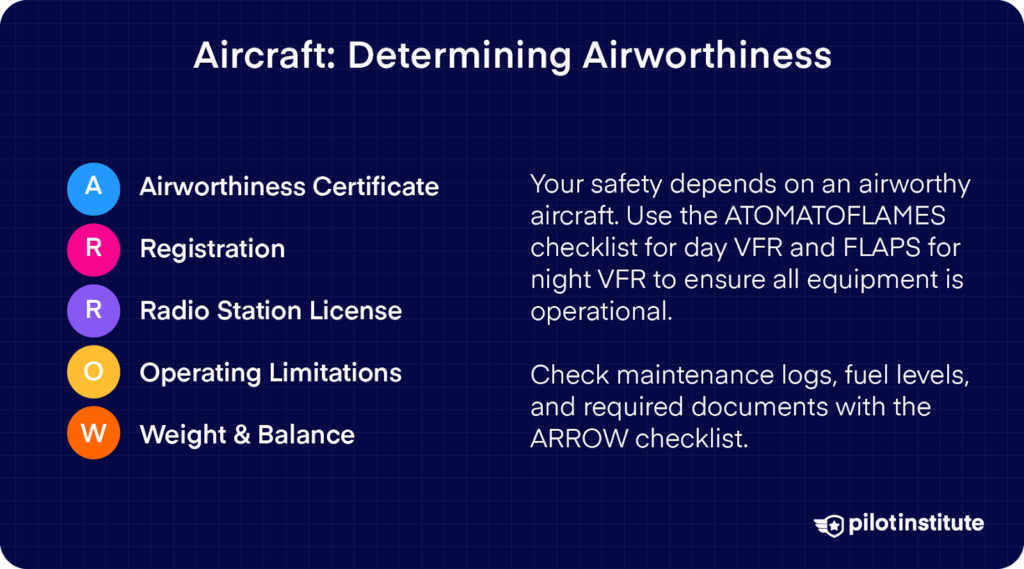
So, you’ve cleared the IMSAFE checklist, and you’re ready to fly. How about your aircraft?
Ensuring your aircraft is airworthy isn’t just a box to check—your safety depends on it.
Maintenance is the backbone of airworthiness. Regular servicing and timely repairs make sure that every part of your aircraft functions properly. This might sound trivial, but routine maintenance catches minor problems before they turn into bigger problems.
Once you’re about to fly, you’ll need to make sure that equipment on board are in working condition. This includes radios, navigation tools, lights, and safety gear.
But with such a long list of components to check, how can you keep track? The ATOMATOFLAMES checklist is a great tool you can use if you’re flying day VFR. It stands for:
- Airspeed Indicator
- Tachometer
- Oil Pressure Gauge
- Manifold Pressure Gauge
- Altimeter
- Temperature Gauge
- Oil Temperature Gauge
- Fuel Gauge
- Landing Gear Position Indicator
- Anti-Collision Lights
- Magnetic Compass
- Emergency Location Transmitter (ELT)
- Safety Belts
And if you’re flying night VFR, you’ll need to include additional components to this list. You can remember them easily using the acronym FLAPS, which stands for:
- Fuses
- Landing light
- Anti-collision lights
- Position lights
- Source of power
How well does your aircraft operate under different conditions? Factors like weight and balance, fuel levels, and even weather all play a role in performance. For example, overloading the aircraft or flying in poor weather can reduce efficiency and safety.
Documentation Checks
Your aircraft’s documentation is your roadmap to its condition and limitations. The ARROW checklist ensures you have the documents required to operate safely and legally. Each letter represents:
- Airworthiness Certificate
- Registration Certificate
- Radio Station License
- Operating Limitations
- Weight and Balance Data
You should also look at the fuel level records and confirm you have enough fuel for your route. Do you have enough reserves for unexpected delays? Double-check the fuel level yourself and ensure it aligns with the amount in the record.
The maintenance logs show whether inspections and repairs are up to date. Check for any issues detected previously and make sure they’ve been fixed.
But it’s not enough to just glance at these documents—you need to review them carefully. Overlooking even one detail could cause serious trouble once you’re airborne.
When Things Go Wrong: A Real-World Example
Here’s a tragic example of what can happen when you don’t prioritize safety checks.
On January 8, 2003, Air Midwest Flight 5481 was scheduled to fly from Charlotte, North Carolina, to Greer, South Carolina.
A mechanic incorrectly set the elevator control cables and skipped an important safety test afterward. This mistake limited the pilot’s ability to control the aircraft’s pitch.
On top of that, the passenger weight estimates were outdated. The aircraft ended up being overloaded by 580 pounds, with its center of gravity positioned too far back.
When these issues combined, it became impossible for the pilot to maintain control after takeoff. Sadly, the aircraft stalled and crashed, leading to the deaths of all 21 people on board.
This accident should serve as a lesson on how safety depends on getting the small details right every single time.
Environment: Analyzing Weather and Terrain
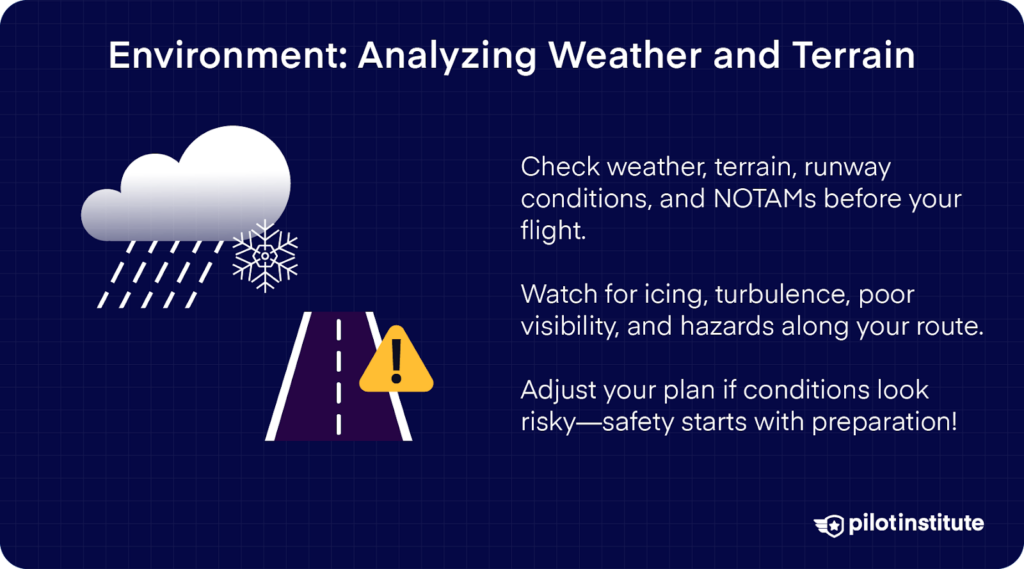
When planning a flight, understanding your environment is just as important as checking the aircraft. When you know the weather and terrain ahead, you set yourself up for safety and success.
This is why the PAVE checklist includes “Environment” as a core factor. It pushes you to consider these elements carefully before you even step into the cockpit.
Weather
Weather is one of the most unpredictable factors in flying; that’s why studying it closely is a big part of pre-flight planning. Before takeoff, always review the latest weather forecasts for your departure, route, and destination.
Which aspects of the weather should you watch out for?
- Icing: Ice buildup can reduce lift and increase drag. Unless managed, this makes the aircraft harder to control.
- Turbulence: Rough air can make flying uncomfortable or even hazardous if severe.
- Visibility: Poor visibility from fog, rain, or low clouds can give you a hard time with navigation and landing.
If the weather seems risky, you’ll need to make adjustments. You might need to delay your departure, choose an alternate route, or cancel the flight if conditions don’t improve.
Terrain and NOTAMs
Weather isn’t the only thing you have to consider. Terrain awareness is just as important, especially when flying in mountainous areas or uneven landscapes. You should know everything about your route’s terrain and plan safe altitudes to avoid obstacles.
Sectional charts are a great resource for identifying elevation changes and hazards along your path. Use this alongside performance charts, which help you understand how different factors will affect your climb performance. Together, they’ll give you a clear picture of your route.
On top of that, you should always check NOTAMs (Notices to Air Missions) before your flight. What do NOTAMs do? They give you updates on temporary hazards, runway closures, or restricted airspace that could affect your plan.
Why Pre-Flight Environmental Planning Matters
As we said, the environment isn’t something you can control. Conditions can change, and forecasts aren’t always perfect. It is, however, something you can plan for.
That’s why checking the environment is a non-negotiable step during pre-flight preparation.
If you notice red flags, like a storm front on your route or critical NOTAM warnings, don’t hesitate to make adjustments. It’s better to delay or change your plan on the ground than to face avoidable risks in the air.
In short, the “Environment” section of the PAVE checklist ensures you’re not caught off guard. Safe flights start with smart preparation, and a well-planned environment assessment is a huge part of that.
External Pressures: Managing Stress and Decision-Making
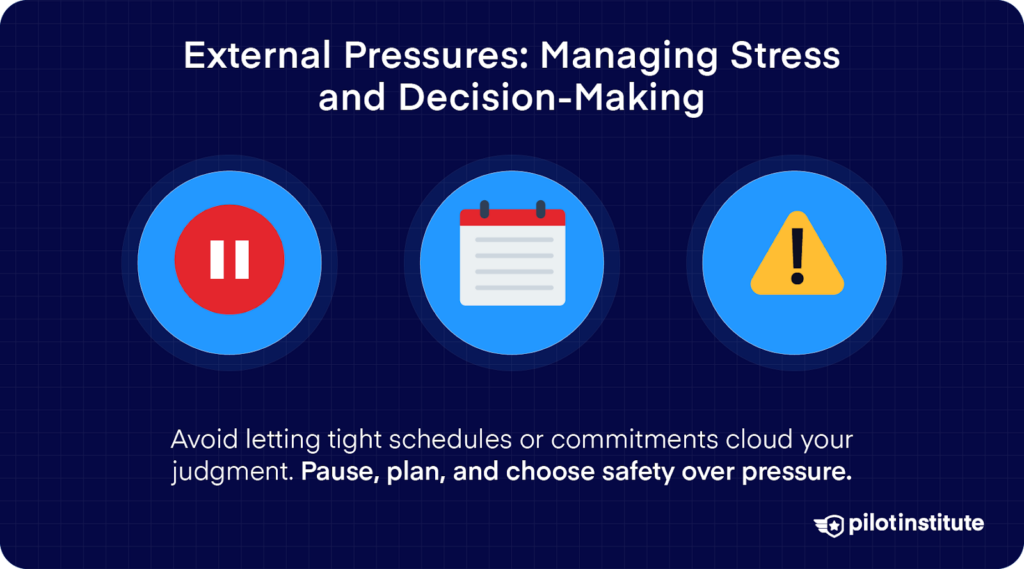
Have you ever felt pressured to stick to a plan, even when things didn’t feel right? That’s what external pressures are all about.
Tight schedules or personal commitments can affect your decision-making. These kinds of outside factors push you into making risky choices.
Maybe your passengers are in a hurry for an event. Or perhaps you’ve promised someone you’d arrive by a certain time.
These pressures can lead to a dangerous mindset called “get-there-itis.” It’s the urge to press on, even when warning signs tell you otherwise.
If this sounds familiar, you might have thought about the term “impulsivity,” a hazardous attitude studied in Aeronautical Decision Making (ADM) training.
Remember that no one is immune to hazardous attitudes, and external pressures can make them even worse. So, let’s examine the other mental traps you might fall for:
- Impulsivity is the habit of acting without thinking, rushing into decisions without considering the consequences.
- Resignation is the belief that you have no control over the outcome, leading to inaction when faced with challenges.
- Macho is the tendency to take unnecessary risks to prove your abilities.
- Invulnerability is the false assumption that accidents only happen to others.
- Anti-authority is a defiant attitude where you ignore rules and procedures, believing they don’t apply to you.
Do you remember the antidotes prescribed by the FAA? They help you snap out of hazardous attitudes and reconsider your choices. These antidotes are:
- Impulsivity: “Not so fast. Think first.”
- Resignation: “I’m not helpless. I can make a difference.”
- Macho: “Taking chances is foolish.”
- Invulnerability: “It could happen to me.”
- Anti-Authority: “Follow the rules. They’re usually right.”
How Do External Pressures Affect Decision-Making?
External pressures can cloud your judgment. Have you ever thought, “It’s probably fine. I’ll keep going,” even when you had doubts? That’s how stress affects decision-making.
When you feel these pressures creeping in, the first step is to recognize them early and address them head-on.
And once you’ve spotted this feeling, here’s what you should do about it:
- Set realistic goals: Give yourself extra time in your schedule for delays. Rushing increases mistakes.
- Be honest with passengers: Let them know safety comes first. Most people will understand if plans change for good reasons.
- Create backup plans: Have alternate routes, landing spots, and a plan B ready before you start.
- Pause and think: When you feel rushed, stop and ask yourself, “Am I making this choice because it’s safe or because I feel pressured?”
External pressures aren’t always obvious, but they have more power than you think. They can sneak into your decision-making process without you realizing it.
When you recognize these pressures and manage them well, you stay in control. It’s better to delay a flight, change your plan, or even cancel entirely than to push forward when conditions aren’t right.
At the end of the day, safety is about the choices you make. Keep your priorities clear, and don’t let external pressures call the shots.
Conclusion
Flying is freedom, but freedom requires responsibility. The PAVE checklist is there to remind you of what’s at stake.
Every decision you make—whether it’s delaying a flight, adjusting your route, or simply pausing to reassess—is a step toward preserving that freedom.
So, let PAVE be more than a checklist.
Fly safe, aviators!

